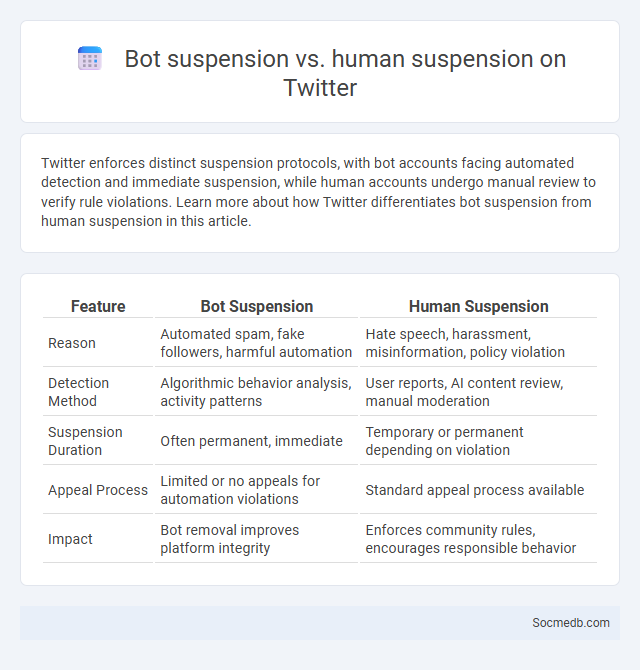
Photo illustration: Bot Suspension vs Human Suspension Twitter
Twitter enforces distinct suspension protocols, with bot accounts facing automated detection and immediate suspension, while human accounts undergo manual review to verify rule violations. Learn more about how Twitter differentiates bot suspension from human suspension in this article.
Table of Comparison
| Feature | Bot Suspension | Human Suspension |
|---|---|---|
| Reason | Automated spam, fake followers, harmful automation | Hate speech, harassment, misinformation, policy violation |
| Detection Method | Algorithmic behavior analysis, activity patterns | User reports, AI content review, manual moderation |
| Suspension Duration | Often permanent, immediate | Temporary or permanent depending on violation |
| Appeal Process | Limited or no appeals for automation violations | Standard appeal process available |
| Impact | Bot removal improves platform integrity | Enforces community rules, encourages responsible behavior |
Understanding Twitter Suspensions: Bot vs Human
Twitter suspensions occur when accounts violate platform policies, with distinctions between automated bots and human users playing a crucial role in enforcement decisions. Bots often face suspensions due to spam, automated behavior, or coordinated manipulation, while human accounts may be suspended for hate speech, harassment, or misinformation. Understanding these differences assists users in complying with Twitter rules and reducing the risk of suspension.
Key Differences Between Bot and Human Account Suspensions
Bot account suspensions typically result from automated detection of suspicious activities such as spam, fake followers, or rapid posting patterns, whereas human account suspensions often stem from violations of community guidelines like hate speech or harassment. Platforms use advanced algorithms and machine learning to differentiate between bots and genuine user behavior, ensuring your account is treated fairly and accurately. Understanding these key differences helps you maintain compliance and avoid unwarranted suspensions on social media.
Common Reasons Behind Twitter Bot Suspensions
Twitter bot suspensions frequently occur due to violations such as spamming behaviors, automated content posting without user consent, fake follower generation, and manipulation of trending topics or hashtags. Algorithms detect unusual activity patterns, including rapid tweet frequency, repetitive content, and engagement in coordinated networks designed to distort platform metrics. Enforcement policies prioritize maintaining authentic user interactions and safeguarding against misinformation and platform abuse.
Typical Causes for Human Account Suspensions on Twitter
Typical causes for human account suspensions on Twitter include repeated violations of platform rules such as hate speech, harassment, and spreading misinformation. Engaging in coordinated harmful behavior or using automated bots to manipulate conversations often results in suspension. Twitter's enforcement relies on detecting abusive language, spam, and attempts to evade previous penalties to maintain community safety and integrity.
Detection Mechanisms: How Twitter Identifies Bots versus Humans
Twitter employs advanced machine learning algorithms and behavioral analysis to distinguish bots from humans by monitoring patterns such as tweet frequency, interaction styles, and metadata signals. Detection mechanisms analyze anomalies in account activity, including repetitive posting, lack of personalization, and unnatural timing, enabling accurate identification of automated accounts. By refining these techniques, Twitter helps ensure Your social media experience remains authentic and secure from bot-driven manipulation.
Appeal Process: Bot Suspension vs Human Suspension
The appeal process for bot suspensions typically involves automated review systems that quickly assess flagged behaviors against platform policies, often resulting in faster but less nuanced resolutions. Human suspensions, in contrast, require manual investigations by support teams, allowing for a more detailed evaluation of context and user intent, which may extend resolution times. Understanding these procedural differences helps users navigate platform compliance and effectively contest suspensions on social media networks like Facebook, Twitter, and Instagram.
Impact of Suspension: Bots vs Real Users
Suspension of social media accounts disproportionately affects bots by significantly reducing automated spam and manipulation activities, thereby enhancing platform integrity and user experience. Real users often face temporary or permanent suspensions that can disrupt genuine social interactions, resulting in loss of content, connections, and digital identity. Effective suspension policies must balance the removal of malicious bot activity with safeguards that protect authentic user participation and trust.
Prevention Tips for Avoiding Twitter Suspension (Bots and Humans)
Regularly review and comply with Twitter's guidelines to avoid suspension due to automated bot activity or human violations. Implement strong security measures, such as two-factor authentication and avoiding third-party apps that violate Twitter's policies. Monitor account activity for unusual behavior and refrain from spammy practices, aggressive following/unfollowing, and posting harmful or misleading content.
Case Studies: Notable Bot and Human Suspensions on Twitter
Twitter's enforcement actions against bot accounts highlight the platform's commitment to maintaining authentic user interactions, exemplified by high-profile suspensions that targeted automated networks spreading misinformation. Human suspensions often involve coordinated campaigns or violations of Twitter's policies on harassment and misinformation, reinforcing the platform's evolving safety measures. Your understanding of these notable case studies can provide insights into how Twitter differentiates between malicious automation and genuine user activity to protect its community.
Future Trends in Twitter Suspensions: Automation vs Human Oversight
Future trends in Twitter suspensions indicate a growing reliance on advanced machine learning algorithms and AI to detect policy violations swiftly, reducing the need for human intervention in clear-cut cases. However, human oversight remains crucial for nuanced decisions involving context, intent, and appeals, ensuring fairness and accuracy in enforcement. Balancing automation with expert review optimizes scalability, transparency, and user trust in content moderation processes.
 socmedb.com
socmedb.com